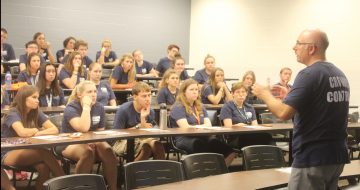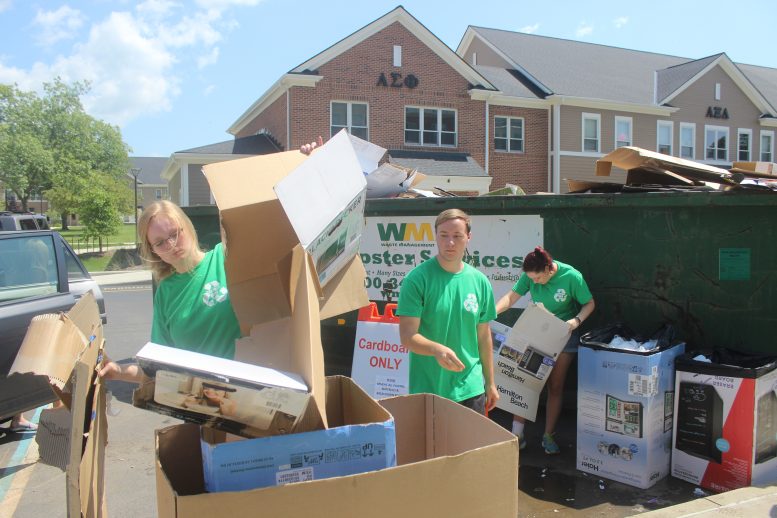By DAVID DUPONT
BG Independent News
In a few weeks, the residents of the Chapman Learning Community will help put up the beams, joists, and deck work for the first Habitat for Humanity homes built in Bowling Green.
Twenty-one years ago, Tom Klein and Brett Holden were among the faculty members who framed out the concept for the Chapman Learning Community, the first learning community at Bowling Green State University.
Holden, who now directs Chapman and oversees all learning community network on campus, said that 1,430 students this year will reside in Learning Communities.

Brett Holden addresses Chapman students during orientation session.
That’s about a quarter of all students who live on campus. Many of the communities are experiencing growth. Chapman, which is located in Kohl Hall along with four other learning communities, has about 70 students, down from a “zenith” of 300. That was too many, the director said.
Since that first chain of calls was made from then President Sidney Ribeau, who had $250,000 in funding to back the idea, to Sue Crawford, dean of continuing education, to Klein to Holden to Ricketts and more, the concept has taken hold at BGSU.
Holden remembers those heady early days. “We were laying the asphalt as fast as we could walk on it.”
Those efforts have paid off. President Rodney Rogers said the university has earned national recognition for its learning communities.
Chapman spawned the Health Science residential community, which has evolved into the Natural and Health Science Community. Then came the community for education majors, now known as Educators in Context and Community.
Then more sprouted up for arts students, music majors, Army ROTC, construction management, Global Village, French and Spanish language communities and more. BGSU now boasts 22, including a couple that are still in the pilot stage.
Some are focused on particular majors, while others are open to students in all disciplines. Some require students to live within a certain dorm, for others that’s optional.
The arrangement brings together students’ living arrangements and academic pursuits, and service to the local and global community – trips to Peru and New Zealand are planned for winter session.
That’s the basis on which Chapman was founded and one of its attractions.
Evelyn Maciejewski, a sophomore at Chapman, said she joined last year, because it seemed a natural extension of the leadership activities as a Girl Scouts and in 4-H.
The learning communities, though, also address some basic concerns facing new students, feelings of loneliness and isolation.
Kristin Carnegis said she joined Chapman last year because of her concerns about how she would adjust to life on at a large university.
“It’s a great transition to college, and great way to meet people and be involved in the university,” said Madison Favorito, also a sophomore in the community.
“These learning communities allow us to deliver a personal experience,” Rogers said. “We can make this feel like a very small environment with all the opportunities of a comprehensive university.”
And they don’t wait long to get to work. Maciejewski, Favorito, and Carnegis were part of the Green Team on Thursday, helping the Office of Sustainability keep cardboard out of the waste stream. Last year the effort diverted 17.1 tons of cardboard, said Nick Hennessey, director of the office of campus sustainability.
The camaraderie is real. After an orientation session Wednesday where slides of community activities flashed on the screen, Brian Harbert, a junior who will live a third year in Chapman, said the smiles on display in those images were genuine. He said he’s not a very social person, but Chapman helped him find a place at BGSU.
Or as Logan Ladden, a sophomore helping on the Green team, said: “It’s a blast.”
But it’s a blast with a purpose. Students can select one of four service learning courses. Holden said the idea is to link learning about problems facing the world with action.
One, taught by philosophy Professor Ian Young, uses work removing invasive species from Wintergarden Park in Bowling Green as a lens to look at environmental issues.
Holly Bird, who teaches General Studies Writing, leads a group that works on pet rescue with the Lucas County Humane Society. Ricketts’ course addresses food insecurity, and collaborates with the meals program at St. Mark’s Lutheran Church.
Holden’s course focuses on the needs of recently deployed military personnel and their families.
They can also take some general education courses in Kohl. However, as more students enter with credit earned through College Credit Plus, this aspect is having to be revised.
Holden said that it’s important for the communities that faculty offices are located in the residence halls with the students. Study groups also are offered in those learning communities that focus on particular disciplines, he said.
While originally aimed at first-year students, after the inaugural year Chapman residents asked what was next for them. So the Chapman Student Leaders program was started. Each of these students serves as a mentor for incoming students. This allows the program both to provide new level of peer support and also to extend its leadership training for another year.
Favorito said she was inspired to sign up for the learning community by a friend from home who was a resident. When Favorito arrived, this friend was her mentor.
“I saw how good she was for me and the rest of the students and how attached she was to the other leaders,” she said. “I wanted to be like them and wanted to influence freshmen the way they influenced me.”
Cecilia Castellano, vice provost for strategic enrollment planning, said that learning communities is definitely a draw that brings students to BGSU.
The options continue to proliferate.
One for members of the Air Force ROTC and students in Forensic Science come on line this fall. Two more, history and social justice, will begin their pilot phases. Holden said faculty will develop the academic side before they become residential communities.
Holden sees more growth in the network. “The challenge is to find the various niches on campus that would benefit from having this kind of community.”
That has to be done carefully, working with everyone involved so it fits within the academic program, residential life, and the learning community network.
And, he said, “you find a motivated, inspiring, student-centered director, and you get them the resources they need to be successful.”
Holden conceded that learning communities not right for every student. Great effort is made to make sure the information given to students, whether by advisors or tour guides, is accurate and consistent “so the students come to us with a sense of what we do and embrace it.”
Holden and other administrators would like to see more students involved.
“This has a profound impact on their personal and academic success,” he said. “They retain at a higher rate. They’re academically more successful. They’re happier. They tend to be more engaged.” All because the program has been designed to accomplish those goals.
And, they have a blast.


